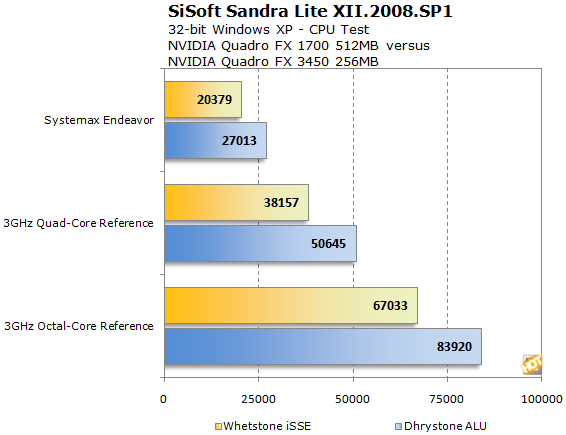Systemax Endeavor Xeon Workstation
Test Systems and SiSoft SANDRA

We ran the Endeavor as it came configured from Systemax. The platform included a 32-bit installation of Windows XP—apparently, Vista still isn’t considered suitable in the professional space, though we do have a Vista workstation here that runs well now that software drivers are much more prolific. The Endeavor was missing some of the latest patches from Windows Update, so those were all installed in order to match our reference configuration.
The hardware in our reference workstation is based largely on Intel’s “V8” content creation platform, minus one of the Xeon X5365 quad-core processors. The platform also shipped with 4GB of FB-DIMM memory. However, we yanked two of the 1GB modules and added an NVIDIA Quadro FX 3450 for comparison’s sake. The 3450 is technically a higher-end card, but because it centers on an older graphics architecture and includes 256MB of memory, the match-up may be closer than expected.
![]()
Test Systems
Intel Inside!
|
Systemax Endeavor Intel Xeon E5310 Quad Core Processor
Supermicro X7DA3+ Motherboard
2GB Kingston DDR2-667 FB-DIMM Memory
NVIDIA Quadro FX 1700 512MB PCI Express Graphics Card Storage
Windows XP Professional 32-bit |
Reference System--Intel "V8" Intel Xeon X5365 Quad Core Processor
Intel S5000XVN Motherboard
2GB Samsung DDR2-667 FB-DIMM Memory
NVIDIA Quadro FX 3450 256MB PCI Express Graphics Card Storage
Windows XP Professional 32-bit
|
|
We started off with a popular synthetic suite of benchmarks able to measure the CPU performance, multi-media alacrity, and memory bandwidth of both Systemax’s Endeavor and our reference workstation platform. SiSoft’s SANDRA, optimized for threading, will demonstrate the potential of going from one quad-core CPU to a pair operating at nearly twice the frequency.
The CPU and multi-media tests aren’t much of a surprise. The sheer muscle of a faster quad-core chip on a faster front side bus is painfully obvious, especially in a synthetic metric that’s going to naturally exaggerate results versus real-world tests. 


The memory bandwidth benchmark is a much closer race, seeing as both platforms are utilizing similar memory capacities, speeds, and memory controller hubs. Nevertheless, Intel’s S5000XVN is able to coax more throughput down the pipe.






